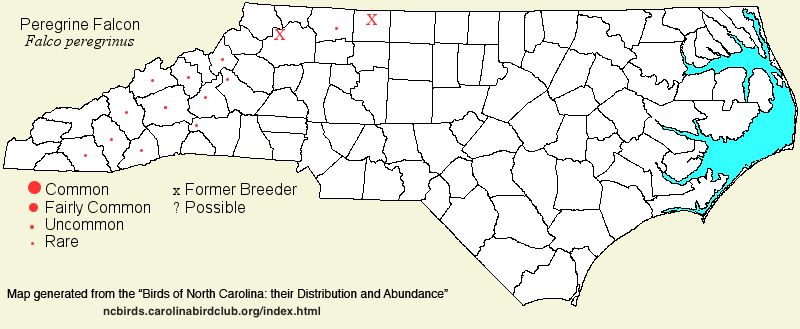 |  |
|
Peregrine Falcon - Falco peregrinus FALCONIDAE Members: | Search Common: Search Scientific: |
|
|
|||||||
| General Comments | As with the Bald Eagle, the Peregrine Falcon populations on the continent nose-dived in the middle parts of the 20th Century because of DDT ingestion and build-up, causing nesting failures. Fortunately, thanks to a hacking project in the state's mountain region -- obtaining pre-fledged young from outside the state and feeding them to fledging/release stage -- a nesting population was re-established in the mountains, where they formerly nested. The nesting population has stabilized at roughly 10-12 nesting pairs since about 2000. Elsewhere, the species is known mainly from coastal areas, where the population has increased as a fall migrant and winter visitor in recent years, as well. Peregrine Falcons nest (in North Carolina) essentially only on ledges in near-vertical cliffs, and forage widely over forests, cliffs, and gorges. However, as with some Peregrine Falcons in other Eastern states, a pair nested (successfully) on a skyscraper, in the Piedmont in 2013. Elsewhere, they are seen where Merlins are often found, typically near shorebird (or waterfowl) concentrations near the coast, or other very open areas near marshes and ponds. They perch less conspicuously than do Merlins and are more wary, but because they are the fastest flying bird in the East, they are even more thrilling to watch as they chase their prey (often a duck or shorebird). | ||||||
| Breeding Status | Breeder | ||||||
| NC BRC List | Definitive | ||||||
| State Status | E | ||||||
| U.S. Status | |||||||
| State Rank | S1B,S2N | ||||||
| Global Rank | G4 | ||||||
| Coastal Plain | Transient, and winter resident near the coast. Along the coast, uncommon to occasionally fairly common fall transient, and uncommon winter resident; rare to uncommon in spring. Rare to uncommon in migration and winter in the Tidewater zone, mostly at refuges such as Mattamuskeet and Alligator River. Farther inland, very rare to rare migrant and winter visitor. Mainly late Sep to mid-May, with a peak from late Sep to late Oct. Peak counts: 15, Nags Head area, 30 Sep 1997. | ||||||
| Piedmont | Transient, with many winter reports; casual breeder. Rare in fall, and very rare to rare in spring, more frequently seen around reservoirs; very rare in winter. Has attempted nesting at Hanging Rock SP and Pilot Mountain SP, both in the foothills, but no young known to have been produced. However, a pair nested successfully on a building in downtown Charlotte in spring 2013. May be uncommon briefly in fall as seen from hawk watch stations in the foothills, such as Pilot Mountain. One apparently overwintered in downtown Charlotte for several years in the late 2000's, as apparently did one in Winston-Salem for one winter in the mid-2000's. Two wintered in downtown Winston-Salem in 2015-16 and 2016-17, and one was suspected of wintering in downtown Durham, being seen on multiple dates in Feb 2016. At least one has been seen sporadically near Raleigh in the winters of 2021-22 and 2022-23. Occurs mainly mid-Sep to late Mar. Peak counts: 4, Pilot Mountain SP, 23 Sep 1992; 4, Jordan Lake, 17 Sep 2007. | ||||||
| Mountains | Permanent resident, with migratory movements. Rare and local breeder, nesting at 10-12 cliff sites. Rare (to occasionally uncommon in fall from hawk watch sites) in fall migration, and very rare to rare in winter and spring (except at nesting sites), mainly in rugged country. Formerly nested regularly prior to about 1950, though details are rather sparse in most cases. Disappeared as a breeder for a few decades until re-nesting was again noted in the mid- to late 1980's. Peak counts (non-breeders): ? | ||||||
| Finding Tips |
In fall and winter, your best bet is the Bodie-Pea Island area, particularly around the impoundments. However, driving NC 12 on Hatteras Island and carefully checking the telephone poles is another good way to see one. In the breeding season, look for them at Chimney Rock Park, Linville Gorge, Devils Courthouse along the Blue Ridge Parkway, and Whiteside Mountain, among a few other sites. ** to *** | ||||||
| Attribution | LeGrand[2024-10-24], LeGrand[2023-03-23], LeGrand[2017-08-23] | ||||||
| NC Map Map depicts all counties with a report (transient or resident) for the species. | Click on county for list of all known species. |
| NC Breeding Season Map Map depicts assumed breeding season abundance for the species. |  |